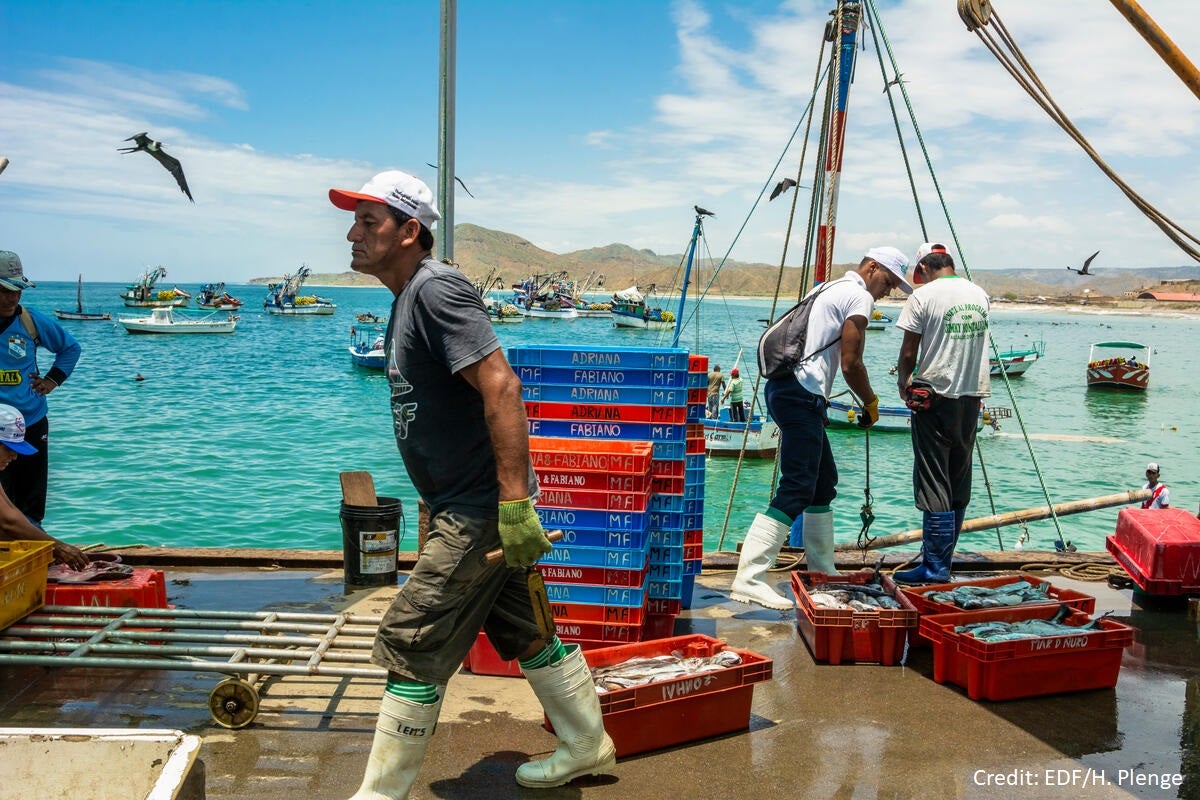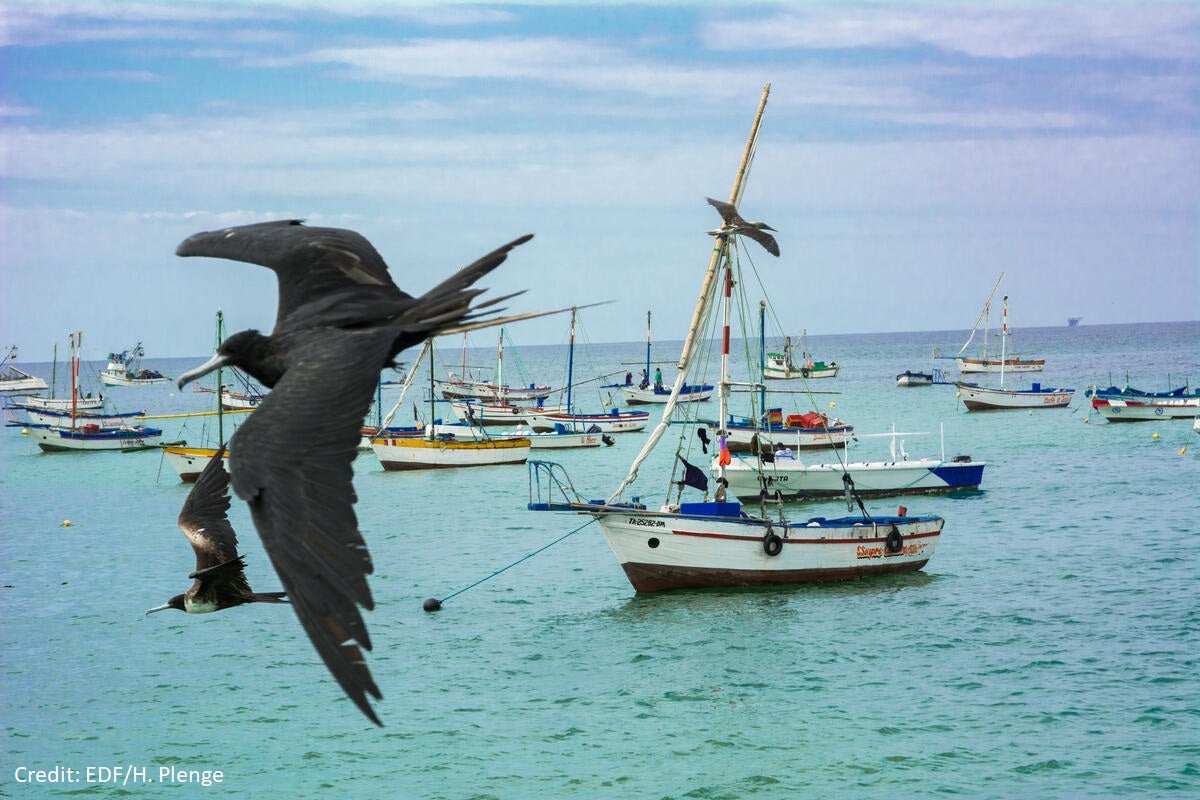By Eric Schwaab, Rod Fujita and Jacqui Vogel
Climate change is already transforming the distribution and abundance of fish stocks around the world. Warming temperatures, lower pH levels and many other factors are causing many fish species to shift to better habitats and others to shrink in abundance. This is problematic for the communities that rely on these stocks, especially when the shifts cross jurisdictional boundaries, such as those between fishery management zones or national exclusive economic zones, known as EEZs.
Climate-induced stock shifts are causing more overfishing, illegal, unregulated, and unreported fishing, discarding, higher fuel use, injustice and even armed conflict. Unless fishery management and fisheries become more adaptive and resilient to climate change, these problems will only worsen, but it’s not too late for solutions like flexible allocation systems, dynamic spatial management, ocean observing systems and international collaboration.
The Challenges
Overfishing
Even without climate change, overfishing is a problem, but climate change can increase overfishing. When stock assessments, allowable catch targets and other regulations do not change rapidly enough to keep pace with changes in fish distribution and abundance, fishers can accidentally overexploit stocks in regions where fish abundance is shrinking. At the same time, fishers in the regions where species are newly abundant may also be overfishing the stock in the absence of appropriate catch limits.
Protected areas and illegal, unregulated and unreported fishing
Over decades, networks of protected areas and associated regulations have been created to reduce interactions between fishers, special habitats and protected resources such as whales, sea turtles and at-risk fish species. Under changing ocean conditions, the existing boundaries of some fishing exclusion zones or time-based restrictions may no longer serve their purpose. Therefore, updating exclusion zones may be necessary.
Further, as fish stocks shift within or beyond their historical ranges and designated fishing zones, there is the potential for these stocks to end up within the boundaries of marine protected areas or other static marine spatial delineations that prohibit fishing or other extractive activities. In these cases, fishers may be tempted to venture into these protected zones and potentially harm the vulnerable resources enclosed within them.
Illegal, unregulated and unreported fishing, or IUU fishing, may also occur as stocks shift across jurisdictional boundaries and into the fishing zones of other nations in which fishing laws or regulations may be different than in the countries from which the stocks have migrated.
Discarding
When fish become more abundant than current regulations allow, fishers may accidentally overstep their allotted catch limits, compelling them to discard part of their catch to remain in compliance with regulations.
Higher fuel use and fishing costs
As fish stocks shift poleward, into deeper waters, or elsewhere as they try to find suitable habitat conditions, some fishermen may chase the fish as they shift into new waters. This increases fuel use and fishing costs and increases the risk of human and labor rights abuses as fishing vessels are forced to stay at sea for longer periods of time in potentially unsafe conditions.
Injustice
Fishers who have stewarded fish stocks for years may feel cheated out of the benefits of their stewardship as fish stocks shift. At the same time, other fishermen who may not have participated in such stewardship efforts may reap the benefits of the conservation and management efforts to which others have dedicated their lives. This may manifest as a form of climate injustice in regions where stocks are shifting from poorer, less-developed nations that contributed little to climate change to wealthier, more-developed ones. There is also potential for cultural loss caused by stocks shifting away from places where they have been integral to traditional practices of indigenous communities.
Geopolitical tensions
Nations or governing bodies, including regional fishery management organizations and fishery management councils, may not be adequately prepared for or even clash over differing views on allocation as stocks shift across geopolitical borders. Stocks entering an exclusive economic zone, or EEZ, can either come from another country’s EEZ or the high seas. If they come from another EEZ, the losing country may follow the fish into the other country’s territory, inciting disagreements or even violence over who has rights to fish these shifting stocks. The two countries experiencing stock gain and loss may disagree over appropriate allocation methods, potentially resulting in prolonged and costly legal battles, lengthy diplomatic proceedings, breakdowns in negotiation and sanction disputes. These tensions may further lead to militarized actions between neighboring countries if allocation disputes are not addressed through diplomatic channels.
Operational issues
As stocks shift into new areas that are unequipped to deal with them, logistical problems may arise, such as port traffic overflow or conflict between fishing vessels and other maritime operations like cruise ships or shipping vessels. In addition, there is further potential for violent altercations between fishers, vessel operators or other ocean users who are encroaching on ocean areas that others may historically claim. Fishers who are traveling farther to follow stocks may also have difficulty finding appropriately equipped ports in which to offload their catch. Unfortunately, many of these problems are already afflicting fisheries around the world.
On-the-water examples of climate-induced fishery problems
One of the most well-known and prolonged climate-induced fishery conflicts erupted between Iceland, the Faroe Islands, Norway and the European Union around 2007. As mackerel started rapidly moving north into the cooler waters surrounding Iceland and the Faroe Islands, disputes broke out between fishers who traditionally caught these stocks off the coasts of the United Kingdom and northern Europe and the Icelandic and Faroese fishers who had suddenly gained access to an abundant mackerel stock. These so-called mackerel wars were partially resolved through a trilateral catch share agreement in 2014. Yet, continued overfishing means that mackerel stocks are still at risk of unsustainable harvesting and the potential reescalation of this conflict remains a risk.
In the Southern hemisphere, climate change is driving changes in fishery productivity and distribution that are, in turn, causing severe management conflicts at the local and international scales. For example, the distribution of juvenile fish is changing, presenting challenges for temporal fishing ground closures designed to enhance juvenile survivorship. Some species traditionally targeted by artisanal fishers in nearshore waters are moving offshore beyond the reach of these fishers. More frequent and intense storm events associated with climate change also hamper artisanal fishers who use small vessels. The species composition of the catch is also changing as some stocks move poleward.
Other examples of climate-induced fishery problems can potentially escalate to violence or physical altercations between the actors involved. In Canada, gear sabotage, such as line-cutting or vessel tampering, and treaty disputes have occurred between indigenous communities and commercial fishers over lobster fishing rights. Opposing claims to emerging fishing waters in the melting Arctic are leading to the potential for physical altercations as Arctic nations converge on these new fishing grounds. And militarized incursions into disputed territories in the South China Sea are leading to heightened geopolitical tensions in this already politically fraught region.
Perhaps because of the magnitude of these problems and the severity of negative impacts on communities and people worldwide, there are many efforts underway to predict, diagnose and potentially avoid these climate-induced fishery problems.
The Solutions
A key facet of climate-resilient fishery management is dynamic allocation. Most fish stocks managed with total allowable catch limits are allocated based on historical catch. This allocation method is often perceived as being fair due to its focus on rewarding previous investments and effort by historical participants in the fishery. However, this can result in misalignment between catch privileges and the actual distribution of the fish when the fish move, leading to many of the problems described above.
In contrast, dynamic allocation would allocate catch limits based on historical catches, which rewards previous investment and effort, and on current stock distribution, which reduces misalignment. The U.S. South Atlantic, Mid-Atlantic and New England regional fishery management councils, as well as the Atlantic States Marine Fishery Commission, recognized these problems several years ago and have been discussing potential solutions, such as dynamic allocation. The Marine Stewardship Council has also recognized the challenge that climate change will present for fishery management and is researching ways to improve its policies to ensure fair quota allocation.
Dynamic spatial management is another method of aligning fishery management with the realities of altered oceans under climate change. New technologies capable of providing near-real-time data on the distribution of fish and catches may make it possible to restrict fishing spatially to protect vulnerable species such as sharks or sea turtles even as the distributions of these species, target species and the fishery itself change due to climate change.
Enhanced ocean observation systems rely on collaboration and innovative technology to foster adaptive fisheries management and provide policymakers with the information they need to confront the challenges of climate change effectively. One such collaborative effort is already underway in the Humboldt Current, where scientists, academia, multilateral institutions, NGOs and the fishery management agencies of Chile, Peru and Ecuador are working together to develop the region’s first comprehensive ocean observation, warning and prediction system. This system, known as Sistema de Alerta, Predicción y Observación, or SAPO, directly responds to fishery management and conservation challenges driven by climate change.
International collaboration is another avenue for addressing the challenges of shifting fish stocks. Agreements that govern shifting stocks from a high level have the potential to create a more comprehensive and unified forum through which to manage fisheries. Management of high seas fish stocks could also prevent conflict or opportunistic exploitation that might occur as stocks shift from national EEZs into the high seas. Agreements like the U.N. Biodiversity of Areas Beyond National Jurisdiction instrument could potentially fill this governance gap and ensure that no stocks go unmanaged or overexploited regardless of physical location.
Secure Fisheries and MARICA are additional programs that focus on conflicts in fisheries. These programs have highlighted climate change as a major driver of fishery conflict and are focused on promoting sustainable fisheries as a deterrent to issues such as food insecurity, armed conflict and geopolitical tensions.
EDF is committed to addressing these climate-induced fishery problems by researching and promoting solutions that can be effectively and equitably translated to the regions around the world in which we work. We are pursuing several projects focused on promoting climate-resilient fisheries via dynamic allocation, conflict avoidance within fisheries and identification of hot spots where rapid adaptation will be necessary to maintain sustainable and healthy fisheries for years to come.













